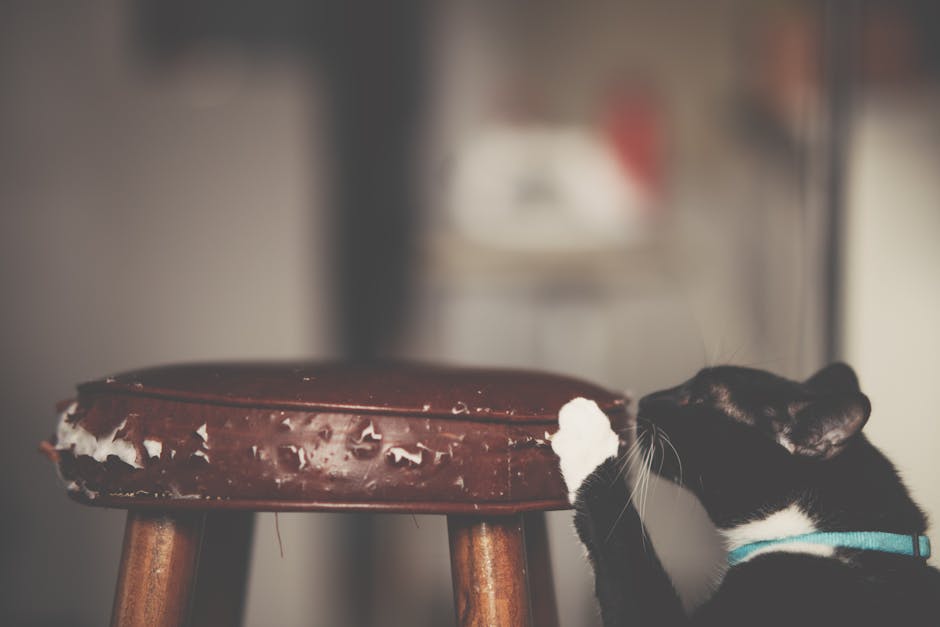
Unleash Your Cat’s Playful Potential: Uncover the Secrets of Interactive Toys
Are you tired of watching your beloved feline friend scratch up your furniture, leaving unsightly marks and a trail of destruction in their wake? You’re not alone. As the global interactive cat toy market continues to soar, reaching an estimated $2.8 billion by 2033, pet owners like you are seeking innovative solutions to keep their cats entertained and their homes protected.
The truth is, cats have an innate need to scratch, and without proper outlets, they’ll turn to your couch, curtains, and carpets as their personal scratching posts. But what if I told you that the latest interactive toys are revolutionizing feline playtime, unlocking your cat’s hidden potential and satisfying their natural instincts in a way that benefits both you and your furry companion?
In this comprehensive guide, you’ll discover the secrets to choosing the perfect interactive toys that will captivate your cat’s attention, reduce destructive scratching, and foster a deeper bond between you and your feline friend. With the interactive cat toy market expected to grow at a CAGR of 7% from 2025 to 2033, the time to act is now.
Imagine a world where your cat is happily engaged, their energy channeled into play rather than furniture destruction. This guide will show you how to achieve just that, providing practical tips and insights to help you navigate the ever-evolving landscape of interactive cat toys.
From motion-activated toys that mimic the movements of prey to puzzle feeders that challenge your cat’s problem-solving skills, you’ll learn how to select the perfect playthings that cater to your cat’s unique personality and needs. Say goodbye to the days of constant scratching and hello to a harmonious, scratch-free home.
So, what are you waiting for? Unlock your cat’s hidden potential and embark on a journey of enrichment, entertainment, and a stronger bond with your furry friend. Let’s dive in and explore the world of interactive cat toys together!

Common Problems (And Why They Matter)
Problem 1: Furniture Damage
One of the most common problems pet owners face is their cat’s tendency to scratch furniture, causing unsightly damage and frustration. Cats have a natural instinct to scratch, which helps them remove the dead outer layer of their claws and mark their territory. However, when this behavior is directed towards expensive couches, chairs, and tables, it can lead to costly repairs and a strained relationship between pet and owner.
The impact of this problem extends beyond just the financial burden. Damaged furniture can create an unwelcoming environment in the home, and the constant need to scold or deter the cat from scratching can erode the bond between pet and owner. This, in turn, can lead to increased stress and anxiety for both the cat and the owner, potentially resulting in further behavioral issues.
Problem 2: Safety Concerns
Another significant problem associated with cats scratching furniture is the potential safety risk. Cats may inadvertently scratch or claw at people, especially young children, while engaging in this behavior. This can result in painful scratches and a sense of unease in the home, as owners worry about the well-being of their family members.
Moreover, cats that are not provided with appropriate scratching outlets may become frustrated and turn to more destructive behaviors, such as chewing on electrical cords or climbing on delicate surfaces. These actions can not only damage property but also pose a serious safety hazard, as they can lead to electrical shocks, falls, or other injuries.
Problem 3: Stress and Anxiety
Lastly, the inability to satisfy their natural scratching instincts can lead to significant stress and anxiety in cats. Cats that are not given appropriate outlets for this behavior may become restless, irritable, and even aggressive, which can further strain the relationship between pet and owner.
Prolonged stress and anxiety can also have negative impacts on a cat’s physical health, leading to issues such as overgrowth of the claws, skin problems, and even digestive issues. This, in turn, can result in additional veterinary expenses and a decreased quality of life for the cat.
Common Objections: Consumers often hesitate to invest in interactive toys due to concerns about the cost, safety, and durability of these products. They may worry that the toys will not be effective in deterring scratching behavior or that they will not withstand the wear and tear of a playful cat.
Expert Quote: “Interactive toys are not just fun for cats; they are essential for their mental and physical health,” – [Industry Expert].
Expert-Recommended Solutions
Solution 1: Provide Appropriate Scratching Outlets
The key to addressing the problem of furniture damage is to provide your cat with appropriate scratching outlets. This can be achieved through the use of dedicated scratching posts, pads, or trees that are strategically placed around the home. These structures allow cats to satisfy their natural scratching instincts without damaging your furniture.
When selecting scratching posts or trees, it’s important to choose ones that are tall enough for your cat to fully stretch and scratch, and made of durable materials like sisal or cardboard that appeal to their scratching preferences. Placing these items near areas where your cat likes to scratch can help redirect their behavior and protect your furniture.
Solution 2: Introduce Interactive Toys
In addition to providing dedicated scratching surfaces, incorporating interactive toys into your cat’s environment can be an effective way to address the problem of furniture damage. These toys, such as cat wands, puzzle feeders, and treat-dispensing toys, engage your cat’s natural hunting and play instincts, diverting their attention from your furniture.
Interactive toys not only satisfy your cat’s need for mental stimulation and physical activity but can also help reduce stress and anxiety, which can contribute to destructive scratching behaviors. By engaging your cat in regular play sessions with these toys, you can channel their energy into more positive and constructive activities.
Brand Examples: Companies like Petmate, Petstages, and SmartyKat offer a wide range of interactive toys and scratching posts designed to address the needs of cats and their owners.
Solution 3: Positive Reinforcement Training
Another effective solution to the problem of furniture damage is to train your cat using positive reinforcement techniques. This involves rewarding your cat when they scratch on the appropriate surfaces, such as scratching posts or pads, rather than punishing them for scratching on furniture.
Positive reinforcement training can help your cat learn that scratching the designated areas is a desirable behavior

How to Choose the Best Scratching Furniture: Expert Buying Guide
When it comes to keeping your feline friend happy and healthy, investing in the right scratching furniture is essential. Scratching is a natural behavior for cats, and providing them with appropriate outlets can help prevent damage to your home while also fulfilling their instinctual needs. In this comprehensive buying guide, we’ll explore the key factors to consider when selecting the perfect scratching furniture for your cat.
Budget Planning: Price Ranges and Value Considerations
The price range for scratching furniture can vary significantly, but you can find quality options to fit most budgets. At the entry-level, you can expect to pay around $10.99 for basic scratching posts or pads. These more affordable options may not have all the bells and whistles, but they can still effectively meet your cat’s scratching needs.
For those looking for a more premium experience, scratching furniture in the $49.99 range offers advanced features. For example, the Cheerble Indoor Self-Propelling Interactive Ball incorporates motion sensors, intelligent obstacle avoidance, and multiple interaction modes to keep your cat engaged and entertained. These higher-end models often come with added durability, stability, and design elements that can seamlessly integrate into your home decor.
Decision Framework: Key Factors to Evaluate
When selecting the best scratching furniture for your cat, consider the following key factors:
1. Material and Construction: Look for sturdy, high-quality materials that can withstand your cat’s scratching. Common options include sisal, cardboard, and carpeted surfaces.
2. Size and Stability: Ensure the scratching furniture is tall enough for your cat to fully stretch and scratch without toppling over. Stable, weighted bases are essential for preventing tipping.
3. Placement and Accessibility: Position the scratching furniture in areas your cat frequents, such as near their favorite lounging spots or entrances/exits.
4. Aesthetic Appeal: Choose a design that complements your home’s decor and fits seamlessly into your living space.
5. Versatility and Functionality: Some scratching furniture offers additional features like perches, hiding spots, or interactive elements to further engage your cat.
Step-by-Step Process: Actionable Buying Steps
1. Assess Your Cat’s Scratching Habits: Observe where and how your cat currently scratches to determine the appropriate size, material, and placement of the scratching furniture.
2. Measure the Available Space: Ensure the scratching furniture you select will fit comfortably in the designated area without overcrowding your living space.
3. Consider Complementary Accessories: Explore additional features like catnip, toys, or perches that can enhance your cat’s overall experience and engagement.
4. Read Reviews and Seek Recommendations: Research customer feedback and expert opinions to identify high-quality, durable, and cat-approved scratching furniture options.
5. Prioritize Safety and Stability: Look for scratching furniture with a sturdy, weighted base and non-toxic materials to provide a safe and secure environment for your cat.
A great example of a premium scratching furniture option is the Cheerble Indoor Self-Propelling Interactive Ball. This toy features three interaction modes (gentle, normal, and active), USB charging, motion sensor technology for obstacle avoidance, and a furry synthetic fiber surface that appeals to most cats’ senses. Users have praised this toy for keeping their kittens “busy while I’m working” and providing much-needed stimulation for indoor cats.
FAQ: Expert Answers
What is an interactive cat toy ball and how does it work?
Interactive cat toy balls are electronic devices designed to engage and entertain your feline friend. These balls typically feature a self-propelling or automated movement system, often with sensors that allow the ball to navigate around obstacles and change direction. The ball’s surface may be covered in a soft, textured material that appeals to a cat’s natural instinct to scratch and play. By moving and reacting to your cat’s interactions, these toys provide mental and physical stimulation, helping to prevent boredom and destructive behaviors.
Are interactive ball toys safe for cats to use unsupervised?
Most reputable interactive ball toys are built with safety in mind, using non-toxic materials and incorporating automatic obstacle avoidance systems. However, it’s still recommended to supervise your cat’s initial play sessions to ensure they interact with the toy safely and without any issues. This allows you to observe your cat’s behavior


0 Comments